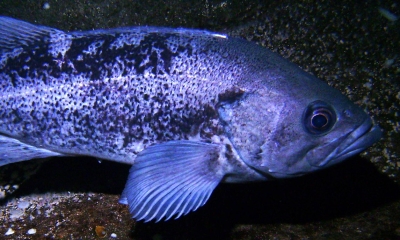
Rockfish
Oregon sport and commercial anglers commonly catch over 25 different species of rockfish. At least 13 additional species occur off Oregon that are infrequently caught. Many of these rockfish have similar characteristics and are difficult to tell apart. All but two species (the thorny heads Sebastolobus alascanus and Sebastolobus altivelis, or idiots) are included in the genus Sebastes. These species are collectively or individually called rockfish, rockcod, snapper, sea bass, and other names. Identification of rockfish species is desirable for good management.

Types of Rockfish

Features: Black rockfish are dark gray to black on top, with a lighter belly, and black spots on their dorsal fins. They can grow to be 25-inches long.
- Take the "Black Rockfish or Not?" quiz
Habitat: They are found over rocky reefs most typically shoreward of 180 ft. of depth, and are common along jetties and other structure in estuaries. Occasionally schools of black rockfish will come all the way to the surface.
Technique: Rockfish feed on squid, octopus, krill, and other fish. They readily take both bait and lures. Common lures include rubber-tailed lead head jigs and shrimp flies.
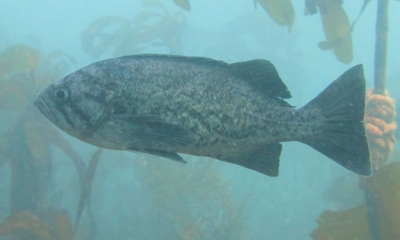
Features: These fish are dark blue or black with a light belly, a blotchy pattern on the sides, and no spots in the dorsal fin. The easiest way to distinguish a blue rockfish from a deacon rockfish is that the blues have jaws that meet together when closed.
Habitat: Like all rockfish, these fish use rocky reefs as habitat. They are common down to 500 feet or more, but also come in to shallow areas. Blue rockfish will often suspend in large schools well off the bottom over rocky areas.
Technique: They readily take both bait and lures. Blue rockfish have smaller mouths than the black rockfish and are more likely to take smaller jigs and shrimp flies.

Features: Canary rockfish are named for their bright yellow to orange mottled bodies. They also have undertones of gray and three orange stripes across their heads. They grow to be 30-inches long, and have very firm and desirable meat.
Habitat: Canary rockfish are a schooling fish, common along the Pacific Northwest coast over rocky reefs and pinnacles. Larger adults are usually further offshore, with younger fish sometimes common down to 100 feet.
Yelloweye, canary and vermillion rockfish can look similar. See this rockfish identification article for distinguishing features for each species.
Technique: They readily take both bait and lures. Locate suspended schools of canary rockfish in offshore areas during periods open for fishing offshore, and work rubber-tail jigs, shrimp flies, or baited hooks through the schools.
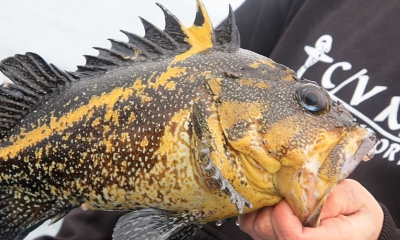
Features: These fish have a dark blue or black body, mottled with yellow and with a broad yellow stripe running along their side.
Habitat: The China rockfish dwells in relatively shallow water, 10- to 400-feet deep, on rocky reefs.
Technique: They readily take both bait and lures. China rockfish will be caught in areas with lots of rocks and crevasses, and by keeping the bait or lure very close to the bottom.

Features: Copper rockfish have variable coloration, ranging from dark or olive-brown to copper with pink or yellow blotches. They can grow to be 23-inches long. They have very tall and strong dorsal fin spines, and a clear patch along the rear half of the lateral line.
Habitat: They prefer rocky, shallow areas. Though these shy fish do not school, they sometimes form small groups around man-made structures such as jetties.
Technique: Copper rockfish will most readily be caught by working rubber tail jigs or bait near the bottom in shallow rocky areas.
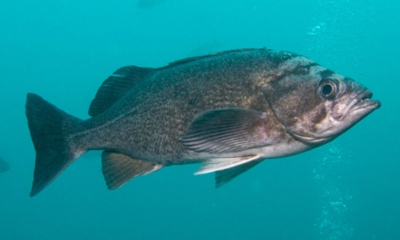
Features: These fish are dark blue or black with a light belly. In fact, they are closely related to blue rockfish, which are similar in appearance. The easiest way to identify a deacon rockfish is by the lower jaw that extends forward creating a significant underbite.
Habitat: Like all rockfish, these fish use rocky reefs as habitat, but commonly suspend well up off the bottom. They are common down to 300 feet or more.
Technique: They readily take both bait and lures. Deacon rockfish have smaller mouths than the black rockfish and are more likely to take smaller jigs and shrimp flies
Header photo by Scott Groth
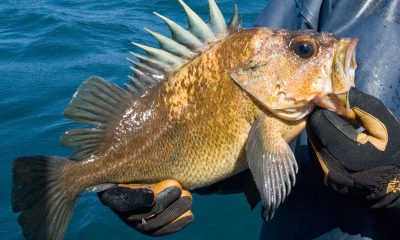
Features: Quillback rockfish are slate-brown and mottled with yellow and orange towards the head, while the rear half of their body is gray to dark brown or black. They have dark brown or black "freckles" on their head and gill cover. They have deeply incised membranes on their very long, spinous dorsal fins. Quillback rockfish can grow to be 24-inches long.
Habitat: They prefer rocky bottoms from the intertidal zone out to 800 feet.
Technique: Quillback rockfish are currently prohibited. Anglers are required to immediately descend back to depth any quillback rockfish encountered outside of the 30-fathom regulatory line and are encouraged to do so at any depth they are encountered.
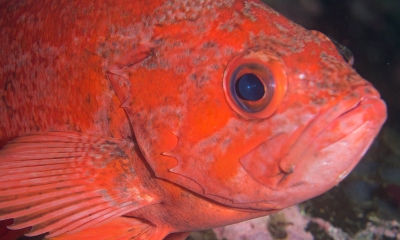
Features: Its deep red sides are mottled with gray. They grow to be 30-inches long.
Yelloweye, canary and vermillion rockfish can look similar. See this rockfish identification article for distinguishing features for each species.
Habitat: The vermilion rockfish is found near the bottom of the ocean over rocky substrate.
Technique: They readily take both bait and lures. Rubber tailed lead head jigs, metal jigs, shrimp flies, and baited hooks will all take vermilion rockfish.
Header photo by Ratha Grimes, Flickr
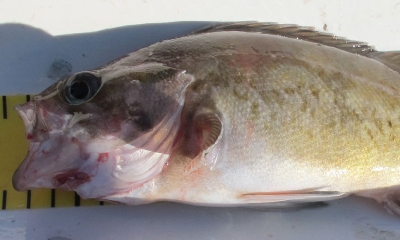
Features: The widow rockfish is brassy brown with a light colored belly. Their fin membranes are also brown. They can grow to be 21-inches long.
Habitat: Widow rockfish school down to 1200 ft., usually found suspended over offshore reefs and rocky areas.
Technique: Best success will be by first locating suspended schools of widow rockfish in offshore areas during periods open for fishing offshore, and then working rubber tail jigs or shrimp flies through the schools.

Features: They are orange red to orange yellow with a bright yellow eyes. Their fin tips may be black. On the top of their head they have a pair of rough ridges.
Yelloweye, canary and vermilion rockfish can look similar.
- See this rockfish identification article for distinguishing features of each species
- Take the "Yelloweye Rockfish or Not?" quiz
Habitat: Juveniles and subadults prefer shallower water than adults, and are associated with rocky reefs,and kelp canopies. Adults move into deeper water as they grow, and prefer rocky bottoms.
Technique: Yelloweye rockfish are currently prohibited in the catch. Anglers are required to immediately descend back to depth any yelloweye rockfish encountered outside of the 30-fathom management line, and encouraged to do so at any depth they are encountered. Yelloweye are best avoided by not fishing near the bottom in rocky habitat at depth of more than 150 feet.
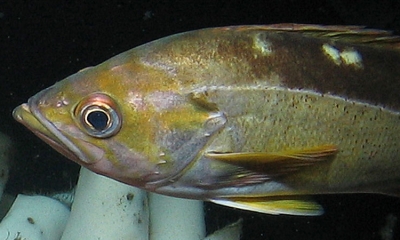
Features: These fish are olive green to dusky-brown with some light mottling towards their top sides. Their fin membranes are yellow.
Habitat: Yellowtail rockfish will usually be found in offshore waters and often suspended over deep reefs and rocky habitat to as deep as 900 feet.
Technique: Best success will be by first locating suspended schools of yellowtail rockfish in offshore areas during periods open for fishing offshore, and then working rubber tail jigs or shrimp flies through the schools.
Features: Pinkish red to copper pink, white ventrally, pink fins. Lateral line in red zone. Second anal spine short, edge of anal fin slants posteriorly. Chin projects outward. No spine on edge of gillraker.
Habitat: Large schools of chilipepper rockfish are often found between 330 and 990 feet. They will stay over sandy, muddy, or rocky bottoms but also spend time in the midwater.
Technique: Play to this species’ midwater foraging nature by presenting lures that mimic their natural diet – forage fish and small squids.
Features: The redstripe rockfish appears red and pink. The dorsal fin is shallowly notched and the lateral line is a distinct red stripe. It has dark lips, a protruding lower jaw, and greenish stripes radiating from the eyes.
Habitat: Commonly found over high-relief, rugged bottoms from 500 feet to 900 feet below the surface.
Technique: Best success will be by first locating suspended schools of redstripe rockfish in offshore areas during periods open for fishing offshore. Work rubber tail jigs or shrimp flies through the schools.
Features: This species is relatively thin compared to other rockfish. It is easily recognized by its three to four horizontal green stripes that extend onto the caudal fin membranes. The body color ranges from white to reddish; red or orange areas can be observed on the body after capture.
Habitat: Though found between 40 and 1,632 foot depths, these rockfish tend to stay between 300 and 825 feet with older/larger individuals found deeper. They live on muddy, sandy and rocky bottoms.
Technique: Rubber tail jigs or shrimp flies are good choices when targeting greenstriped rockfish. Be wary of sharp dorsal, pelvic, and anal spines when landing your catch.
Features: Olive brown to red on back, silvery-red to pink on sides. Lower jaw is long and extends at least to the eye socket. Short second anal fin spine. These fish can grow up to 3 feet long.
Habitat: Most common between 160 and 820 feet deep. Adults show a preference to stay close to their home swatch of rocky bottoms or outcrops.
Technique: Their diet consists of invertebrates and small fishes – try a lure that mimics these sea creatures.
Features: These fish are dark green, gray or brown on top with an off-white belly and silver or tan sides. The underside of the head and fins can be pinkish. Long second anal fin spine. Silvergrays can be confused with bocaccio rockfish which have a short second anal fin spine.
Habitat: Most commonly found between 330 and 990 feet though subadults have been found in kelp beds only 56 feet deep. Adults live over various rocky-bottom habitats.
Technique: Work rubber tail jigs or shrimp flies through the schools containing these fish.

